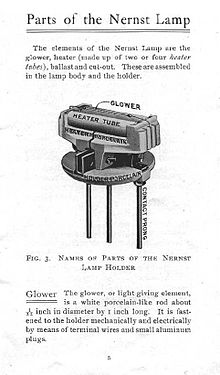Nernst lamp
The Nernst lamp (also Nernst lamp ) has been prepared by physical chemist Walther Nernst in Göttingen signed in 1897 for a patent. This incandescent lamp was more efficient than the carbon filament lamp used at the time and also provided a more natural light, more like daylight. Magnesium oxide and mixtures of zirconium dioxide and yttrium oxide were used for the incandescent body ( Nernst pin ) .
In contrast to the carbon filament lamp, the Nernst lamp did not require a vacuum (or protective gas as in the later metal filament lamp ), but could (or even had to) be operated in air . The electrical conductivity is not due to electrons as metals, but on ionic conduction of doubly negatively charged oxygen - ions .
However, this conductivity only sets in at high temperatures, so that the incandescent body of the Nernst lamp first had to be preheated, with simple versions with a match or a spirit burner , with more comfortable models with an electric heater (heating coil made of platinum ). It took about half a minute until the incandescent body was sufficiently conductive to be kept at a high temperature by itself by the flow of current. The operating temperature of the lamp is around 1600 ° C. The service life of the glow rod was given as around 700 hours, that of the heating wire as around 2000 hours.
Nernst sold his patent to AEG ( Emil Rathenau ). The Nernst lamp was manufactured by AEG in Berlin and Westinghouse (Nernst Lamp Company) in Pittsburgh . It was presented with great success at the World Exhibition in Paris in 1900. The number of Nernst lamps produced is given as around four million. From around 1910 onwards, it was replaced by metal filament lamps based on the principle of today's incandescent lamps , but initially had advantages when operated with high voltages (220 V), because at first it was not possible to produce sufficiently thin metal wires (e.g. made of tungsten ).
For special applications, particularly as a radiation source in infrared spectroscopy , Nernst pens were still used as standard until the 1990s. Because of their high operating temperature of 1900 K in the middle IR range, they show a very favorable spectral energy distribution.
See also
- Globar (infrared heater made of silicon carbide )
Web links
- Nernst lamp on nernst.de
literature
- Alexander Kraft: Chemistry in Berlin - history, traces, personalities , Berlin Story Verlag Berlin, 2012, ISBN 978-3-86368-060-2
- Max Vogtherr: Die Chemie , J. Neumann, Neudamm, 1918.
References and comments
- ↑ Patent DE104872 : Method for generating electrical incandescent light. Registered July 8, 1899 , published July 6, 1897 , inventor: Walther Nernst ( online ).
- ^ Vogtherr: Die Chemie , p. 459
- ↑ The mixtures of zirconium dioxide and yttrium oxide are used today as YSZ (yttria stabilized zirconia) in the lambda probe and for high-temperature fuel cells of the SOFC type (solid oxide fuel cell) .
- ↑ Alexander Kraft: Chemistry in Berlin . History, traces, personalities. 1st edition. Berlin Story Verlag, Berlin 2012, ISBN 978-3-86368-060-2 , Walther Nernst (1864-1941), pp. 252-254 .

